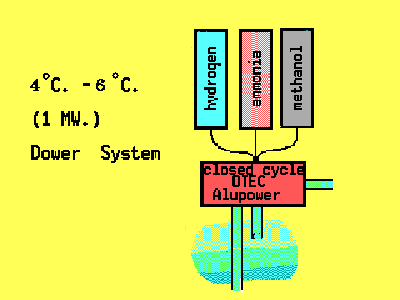THE ELECTRICAL POWER SUBSYSTEM
THE ELECTRICAL POWER SYSTEM

The power subsystem is shown schematically in the accompanying illustration.
Of the two fundamentally different types of electrical energy generating
systems, open and closed cycle, only the closed cycle system in the one megawatt
size is available for immediate implementation. Ideally the system will receive
deep ocean water at a temperature of from 4 -6 Degrees C. and will discharge it
at a temperature of 7 - 8 Degrees C. The closed cycle system is a well known
thermal system. It was first demonstrated as producing net power from Ocean
Thermal Energy Conversion in a facility at the Natural Energy Laboratory of
Hawaii. The plant was designated as Mini-OTEC. As of this writing four such
demonstration plants have been produced.
 A key to the entire system is the deep ocean water pipe. Nine such
pipes have been installed at the NELH. It is now clear that pipes as large as 24
inches in diameter can be installed by local fishermen and other public works
technicians found in island and coastal communities. Few, if any difficulties
are found in the deep ocean installation since the pipe material is buoyant and
hangs in an inverse catenary which is anchored to the ocean floor in the deep
and shallow waters at the pipe extremities. Survival problems can be encountered
in the transition zone from sea to land. Recent successful experiments with
slant drilling suggest that this technique will provide a low cost method for
crossing the coastal zone.
A key to the entire system is the deep ocean water pipe. Nine such
pipes have been installed at the NELH. It is now clear that pipes as large as 24
inches in diameter can be installed by local fishermen and other public works
technicians found in island and coastal communities. Few, if any difficulties
are found in the deep ocean installation since the pipe material is buoyant and
hangs in an inverse catenary which is anchored to the ocean floor in the deep
and shallow waters at the pipe extremities. Survival problems can be encountered
in the transition zone from sea to land. Recent successful experiments with
slant drilling suggest that this technique will provide a low cost method for
crossing the coastal zone.
Although the demonstration plants produced net power economic feasibility
was not demonstrated until the Aluminum Company of Canada and the General
Electric Company of Great Britain (now Alupower) collaborated on the development
of low cost long lived heat exchangers. This was done using the conventional
roll bond process employed with aluminum heat exchangers for conventional
refrigerators. Extensive testing of these components and materials at the NELH
permitted the design of a low cost heat exchanger module and the construction of
test bed for a one megawatt system at Lynnemouth England The success o this
development is maturing in a demonstration plant (200 kilowatts) for NELH which
will serve as a demonstrator in a total system development as previously
described.
In most small village applications there will not be an extensive or
complete power grid. In such instances the best use of the OTEC electricity will
be in the generation of transportable fuels. The system illustration suggests
that methanol, ammonia and hydrogen are all candidates. Avery of the Johns
Hopkins Applied Physics Laboratory has analyzed processes for the generation of
methanol utilizing some readily available carbon source such as charcoal. He has
also examined elementary processes for the manufacture of ammonia. Unfortunately
neither of these processes has yet been developed for use in any system of
immediate application. On the other hand the University of Kiel has developed
efficient electrolytic processes which benefit from the use of cold water of
high salinity. Although costly in terms of initial capital investment this
process does not seem economical in the usual western financial computation.
However the cost is all in the initial capitalization with a lifetime of fifty
years easily achieved. Thus a capital intensive 'gift' from a development agency
would relieve the donor of any further responsibility for the donee community
for many years. Thus the manufacture of hydrogen will be included in the list of
components which are immediately available and economically practicable.
Hydrogen is certainly environmentally sustainable.
The most recent
development is the receipt of the heat exchangers for the "1 megawatt closed
cycle demonstration plant". The cold water effluent from this plant will be
employed in the coldwater agriculture garden of the Common Heritage Corp. and
may be employed for the landscaping of the power plant facility.
The other
applications for the cold water effluent are discussed in the next section on
the Cold Utilization
Subsystem

 A key to the entire system is the deep ocean water pipe. Nine such
pipes have been installed at the NELH. It is now clear that pipes as large as 24
inches in diameter can be installed by local fishermen and other public works
technicians found in island and coastal communities. Few, if any difficulties
are found in the deep ocean installation since the pipe material is buoyant and
hangs in an inverse catenary which is anchored to the ocean floor in the deep
and shallow waters at the pipe extremities. Survival problems can be encountered
in the transition zone from sea to land. Recent successful experiments with
slant drilling suggest that this technique will provide a low cost method for
crossing the coastal zone.
A key to the entire system is the deep ocean water pipe. Nine such
pipes have been installed at the NELH. It is now clear that pipes as large as 24
inches in diameter can be installed by local fishermen and other public works
technicians found in island and coastal communities. Few, if any difficulties
are found in the deep ocean installation since the pipe material is buoyant and
hangs in an inverse catenary which is anchored to the ocean floor in the deep
and shallow waters at the pipe extremities. Survival problems can be encountered
in the transition zone from sea to land. Recent successful experiments with
slant drilling suggest that this technique will provide a low cost method for
crossing the coastal zone.